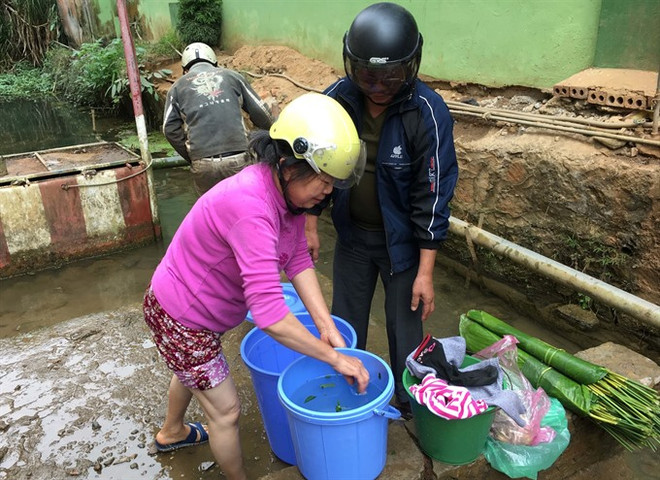 Residents in the northern city of Sơn La wash clothes and vegetables in water collected in plastic buckets (Photo: VNA)
Residents in the northern city of Sơn La wash clothes and vegetables in water collected in plastic buckets (Photo: VNA)Hanoi (VNA) - Widespread water pollutionnationwide has inflicted an estimated economic loss of 11.6 trillion VND (510.7 million USD) in the last ten years and the situation is not gettingbetter, an environmental expert says.
Nguyen Ngoc Ly, Director of the Hanoi-basedCentre for Community and Environment Research said rapid urbanisation andindustrialisation were generating more and more pollutants, and the waterenvironment had been badly hit.
Apart from the economic losses, waterpollution had had serious health impacts, she said.
Fixing water pollution required hugefunding, Ly said, citing as an example the efforts made to clean the 8km longNhieu Loc Canal in HCM City.
The restoration work, ongoing since 2008,has taken many years and 685 million USD thus far.
Nguyen Van Thuy, Director of the Centre forEnvironment Monitoring, said Vietnam has about 3,450 rivers and springs withlength of at least ten kilometers each, their total surface water is about 830billion cubic metres.
The major rivers in the three regions are:Hong (Red) River, Thai Binh River, Bang Giang River, Ky Cung River, Ma River,and Ca River in the north; Vu Gia River, Thu Bon River and Ba River in thecentre; and Dong Nai River and MekongRiver in the south.
The water volumes in these rivers wereshowing vast differences during different seasons, and the quality of the waterhad also degraded, and the risks of water exhaustion were alarmingly visible,Thuy said.
He said that in the Red River Delta, 80 percentof water used for daily activities became wastewater, making the region thelargest wastewater discharger in the country.
The wastewater contained many pollutantsincluding those generated by industrial production in trade villages,industrial zones, hospitals and farms, Thuy said, emphasising that water pollutionwas a major challenge for the region and the country.
According to the Construction Ministry,Vietnam has 37 wastewater treatment plants in urban areas with capacity of890,000 cubic metres daily, dealing with just 12-13 percent of discharged wastewater.
Nguyen Hong Quan from the Institute ofEnvironment and Natural Resources under HCM City National University told theSai Gon Giai phong (Liberated Saigon) newspaper that demand for water andwastewater treatment increased along with urbanisation.
But the water supply system and wastewatertreatment facilities in Vietnam had failed to meet the rising demand, partlybecause of modest funding, with private investors showing no interest in thesector, Quan said.
The National Environment Report 2016,released in the middle of this year by Ministry of Natural Resources andEnvironment, says that on average, an urban dweller consumes 105 litres ofwater daily and in big cities like Hanoi or HCM City, the water consumption perhead is about 120-130 litres a day.
About 40 percent of water consumption inurban areas in Vietnam is from underground sources. HCM City and Hanoi useabout 2.63 million cubic metres of water per day, accounting for nearly 26 percentof the total water consumption in the country.
The report says that improper exploitationand use have decreased both quantity and quality of water in urban areasincluding HCM City, Hanoi, Vinh Yen city in Vinh Phuc province and Soc Trang city in the province of the same name.
Overexploitation of underground water hasalso caused water pollution in Hanoi, Phu Ly city in the northern province ofHa Nam, and land depression in HCM City and Ca Mau city.
According to Water Resources ManagementDepartment under the Environment Ministry, between 1992 and 2013, averagegroundwater levels in Hanoi fell by 0.08-0.91 metres every year. This hasworsened the degradation of fresh water resources, leading to reducedefficiency in exploitation and increased risks of pollution and landdepression.
Urban water supply pipe systems are said tohave degraded in all localities, resulting in wastage as well as pollution.
Last year, Hanoi reported a supply of880,000- 900,000 cubic metres of water every day, but lost 23 percent becauseof degraded water pipelines. In 2014-2016, the water supply pipeline from Da River to the city broke 16 times.
Severe water pollution has been detected inurban areas with excessive concentration of ammoniac as well as heavy metalslike lead, arsenic and manganese.
In Hanoi, water in Hoang Mai and Long Biendistricts has been contaminated by arsenic for years. High concentrations ofiron were found in the districts of Hai Ba Trung, Ba Dinh, Ha Dong, Thanh Xuan,Tay Ho, Hoang Mai, Bac Tu Liem and Nam Tu Liem.
The concentration of ammoniac was found tobe dozens of times higher than permittedlevels in almost all 34 wells located near 13 water treatment and supplystations in the city.
Residents are very worried about the healthimplications of such reports.
For examples, arsenic is a chemical elementfound in nature and some manmade products like pesticides. Consumption of0.3-30mg of arsenic can cause acute poisoning within 30-60 minutes. Long-termexposure to the element can damage the nervous, cardiovascular and digestivesystems and increase the risk of cancer.
High concentration of iron and/or ammoniaccan change taste, colour and characteristics of food, making them lessdigestive or more prone to triggering diseases.
Ly from the Centre for Community andEnvironment Research said that Vietnam had relatively proper legal framework tomanage its water resources, but enforcement has been weak.
He said stronger law enforcement andimproved legal frameworks were needed to protect fresh water resources andcontrol water pollution.
Other experts have called for acomprehensive, thorough plan to dredge and clean polluted rivers and canals,improve wastewater treatment works, upgrade urban sewage systems anddrastically limit the exploitation and use of underground water.-VNA





























